Automated Assessment of Green Infrastructure Using E-nose, Integrated Visible-Thermal Cameras and Computer Vision Algorithms
Abstract
1. Introduction
2. Materials and Methods
2.1. Urban Infrastructure Test Site
2.2. Weather Data from the Trial Site
2.3. Electronic-Nose
2.4. Visible and Thermal Infrared Integrated Cameras
2.5. Measurement Setup and Data Acquisition
2.6. Data Processing and Computer Vision Algorithms
2.7. Data Synchronization
2.8. Statistical Analysis
2.9. Machine Learning
3. Results and Discussion
3.1. Weather Data from BoM
3.2. Air Monitoring via E-nose
3.3. Plant Water Status from Thermal IR Images
3.4. Canopy Growth Monitoring Obtained via RGB Videos and Computer Vision Analysis
3.5. Modelling Using ANN
3.6. Limitations and Future Work
4. Conclusions
Author Contributions
Funding
Institutional Review Board Statement
Informed Consent Statement
Data Availability Statement
Acknowledgments
Conflicts of Interest
References
- Kumar, P.; Druckman, A.; Gallagher, J.; Gatersleben, B.; Allison, S.; Eisenman, T.S.; Hoang, U.; Hama, S.; Tiwari, A.; Sharma, A.; et al. The nexus between air pollution, green infrastructure and human health. Environ. Int. 2019, 133, 105181. [Google Scholar] [CrossRef]
- Norton, B.A.; Coutts, A.M.; Livesley, S.J.; Harris, R.J.; Hunter, A.M.; Williams, N.S. Planning for cooler cities: A framework to prioritise green infrastructure to mitigate high temperatures in urban landscapes. Landsc. Urban Plan. 2015, 134, 127–138. [Google Scholar] [CrossRef]
- Hashad, K.; Gu, J.; Yang, B.; Rong, M.; Chen, E.; Ma, X.; Zhang, K.M. Designing roadside green infrastructure to mitigate traffic-related air pollution using machine learning. Sci. Total Environ. 2021, 773, 144760. [Google Scholar] [CrossRef] [PubMed]
- Gates, D.M. Transpiration and leaf temperature. Annu. Rev. Plant Physiol. 1968, 19, 211–238. [Google Scholar] [CrossRef]
- Doick, K.; Hutchings, T. Air Temperature Regulation by Urban Trees and Green Infrastructure; Forestry Commission: Edinburgh, UK, 2013. [Google Scholar]
- Jennings, V.; Reid, C.E.; Fuller, C.H. Green infrastructure can limit but not solve air pollution injustice. Nat. Commun. 2021, 12, 2672. [Google Scholar] [CrossRef] [PubMed]
- Wilson, A.D.; Baietto, M. Applications and advances in electronic-nose technologies. Sensors 2009, 9, 5099–5148. [Google Scholar] [CrossRef] [PubMed]
- Röck, F.; Barsan, N.; Weimar, U. Electronic nose: Current status and future trends. Chem. Rev. 2008, 108, 705–725. [Google Scholar] [CrossRef]
- Pearce, T.C.; Schiffman, S.S.; Nagle, H.T.; Gardner, J.W. (Eds.) Handbook of Machine Olfaction: Electronic Nose Technology; Wiley-VCH: Weinheim, Germany, 2006. [Google Scholar] [CrossRef]
- Scott, S.M.; James, D.; Ali, Z. Data analysis for electronic nose systems. Microchim. Acta 2006, 156, 183–207. [Google Scholar] [CrossRef]
- Hayasaka, T.; Lin, A.; Copa, V.C.; Lopez, L.P.; Loberternos, R.A.; Ballesteros, L.I.M.; Kubota, Y.; Liu, Y.; Salvador, A.A.; Lin, L. An electronic nose using a single graphene FET and machine learning for water, methanol, and ethanol. Microsyst. Nanoeng. 2020, 6, 50. [Google Scholar] [CrossRef]
- Zhang, L.; Tian, F.; Nie, H.; Dang, L.; Li, G.; Ye, Q.; Kadri, C. Classification of multiple indoor air contaminants by an electronic nose and a hybrid support vector machine. Sens. Actuators B Chem. 2012, 174, 114–125. [Google Scholar] [CrossRef]
- Zhang, L.; Tian, F.; Liu, S.; Guo, J.; Hu, B.; Ye, Q.; Dang, L.; Peng, X.; Kadri, C.; Feng, J. Chaos based neural network optimization for concentration estimation of indoor air contaminants by an electronic nose. Sens. Actuators A Phys. 2013, 189, 161–167. [Google Scholar] [CrossRef]
- Shooshtari, M.; Salehi, A. An Electronic Nose Based on Carbon Nanotube–Titanium Dioxide Hybrid Nanostructures for Detection and Discrimination of Volatile Organic Compounds. Sensors Actuators B Chem. 2022, 357, 131418. [Google Scholar] [CrossRef]
- Arasaradnam, R.P.; Quraishi, N.; Kyrou, I.; Nwokolo, C.U.; Joseph, M.; Kumar, S.; Bardhan, K.D.; Covington, J.A. Insights into ‘fermentonomics’: Evaluation of volatile organic compounds (VOCs) in human disease using an electronic ‘e-nose’. J. Med. Eng. Technol. 2011, 35, 87–91. [Google Scholar] [CrossRef]
- Zhu, L.; Zeng, W. Room-temperature gas sensing of ZnO-based gas sensor: A review. Sens. Actuators A Phys. 2017, 267, 242–261. [Google Scholar] [CrossRef]
- Zhang, Y.; Li, D.; Qin, L.; Zhao, P.; Liu, F.; Chuai, X.; Sun, P.; Liang, X.; Gao, Y.; Sun, Y.; et al. Preparation and gas sensing properties of hierarchical leaf-like SnO2 materials. Sens. Actuators B Chem. 2018, 255, 2944–2951. [Google Scholar] [CrossRef]
- Jin, P.P.; Zou, X.; Zhou, L.J.; Zhao, J.; Chen, H.; Tian, Y.; Li, G.D. Biopolymer-assisted construction of porous SnO2 microspheres with enhanced sensing properties. Sens. Actuators B Chem. 2014, 204, 142–148. [Google Scholar] [CrossRef]
- Long, H.; Zeng, W.; Zhang, H. Synthesis of WO3 and its gas sensing: A review. J. Mater. Sci. Mater. Electron. 2015, 26, 4698–4707. [Google Scholar] [CrossRef]
- Zhang, Y.; Zeng, W.; Li, Y. NO2 and H2 sensing properties for urchin-like hexagonal WO3 based on experimental and first-principle investigations. Ceram. Int. 2019, 45, 6043–6050. [Google Scholar] [CrossRef]
- Chava, R.K.; Oh, S.Y.; Yu, Y.T. Enhanced H2 gas sensing properties of Au@In2O3 core–shell hybrid metal–semiconductor heteronanostructures. CrystEngComm 2016, 18, 3655–3666. [Google Scholar] [CrossRef]
- Wang, X.; Meng, Y.; Li, G.D.; Zou, Y.; Cao, Y.; Zou, X. UV-assisted, template-free synthesis of ultrathin nanosheet-assembled hollow indium oxide microstructures for effective gaseous formaldehyde detection. Sens. Actuators B Chem. 2016, 224, 559–567. [Google Scholar] [CrossRef]
- Bigiani, L.; Maccato, C.; Carraro, G.; Gasparotto, A.; Sada, C.; Comini, E.; Barreca, D. Tailoring vapor-phase fabrication of Mn3O4 nanosystems: From synthesis to gas-sensing applications. ACS Appl. Nano Mater. 2018, 1, 2962–2970. [Google Scholar] [CrossRef]
- Cao, S.; Han, T.; Peng, L.; Liu, B. Hydrothermal preparation, formation mechanism and gas-sensing properties of novel Mn3O4 nano-octahedrons. Mater. Lett. 2019, 246, 210–213. [Google Scholar] [CrossRef]
- Ji, H.; Zeng, W.; Li, Y. Gas sensing mechanisms of metal oxide semiconductors: A focus review. Nanoscale 2019, 11, 22664–22684. [Google Scholar] [CrossRef]
- Hong, S.; Wu, M.; Hong, Y.; Jeong, Y.; Jung, G.; Shin, W.; Park, J.; Kim, D.; Jang, D.; Lee, J.H. FET-type gas sensors: A review. Sens. Actuators B Chem. 2020, 329, 129240. [Google Scholar] [CrossRef]
- Green, J.K.; Seneviratne, S.I.; Berg, A.M.; Findell, K.L.; Hagemann, S.; Lawrence, D.M.; Gentine, P. Large influence of soil moisture on long-term terrestrial carbon uptake. Nature 2019, 565, 476–479. [Google Scholar] [CrossRef]
- Chen, H.; Markham, J. Ancient CO2 levels favor nitrogen fixing plants over a broader range of soil N compared to present. Sci. Rep. 2021, 11, 3038. [Google Scholar] [CrossRef]
- Cheng, Y.; Wang, J.; Chang, S.X.; Cai, Z.; Müller, C.; Zhang, J. Nitrogen deposition affects both net and gross soil nitrogen transformations in forest ecosystems: A review. Environ. Pollut. 2019, 244, 608–616. [Google Scholar] [CrossRef]
- Ernst, J.W.; Massey, H.F. The effects of several factors on volatilization of ammonia formed from urea in the soil. Soil Sci. Soc. Am. J. 1960, 24, 87–90. [Google Scholar] [CrossRef]
- Fan, X.X.; Xu, Z.G.; Liu, X.Y.; Tang, C.M.; Wang, L.W.; Han, X.L. Effects of light intensity on the growth and leaf development of young tomato plants grown under a combination of red and blue light. Sci. Hortic. 2013, 153, 50–55. [Google Scholar] [CrossRef]
- Penn, C.J.; Camberato, J.J. A critical review on soil chemical processes that control how soil pH affects phosphorus availability to plants. Agriculture 2019, 9, 120. [Google Scholar] [CrossRef]
- Eden, M.A.; Hill, R.A.; Beresford, R.; Stewart, A. The influence of inoculum concentration, relative humidity, and temperature on infection of greenhouse tomatoes by Botrytis cinerea. Plant Pathol. 1996, 45, 795–806. [Google Scholar] [CrossRef]
- Coulter, L.L.; Stow, D.A.; Tsai, Y.H.; Ibanez, N.; Shih, H.C.; Kerr, A.; Benza, M.; Weeks, J.R.; Mensah, F. Classification and assessment of land cover and land use change in southern Ghana using dense stacks of Landsat 7 ETM+ imagery. Remote Sens. Environ. 2016, 184, 396–409. [Google Scholar] [CrossRef]
- Solano, F.; Di Fazio, S.; Modica, G. A methodology based on GEOBIA and WorldView-3 imagery to derive vegetation indices at tree crown detail in olive orchards. Int. J. Appl. Earth Obs. Geoinf. 2019, 83, 101912. [Google Scholar] [CrossRef]
- Näsi, R.; Honkavaara, E.; Blomqvist, M.; Lyytikäinen-Saarenmaa, P.; Hakala, T.; Viljanen, N.; Kantola, T.; Holopainen, M. Remote sensing of bark beetle damage in urban forests at individual tree level using a novel hyperspectral camera from UAV and aircraft. Urban For. Urban Green. 2018, 30, 72–83. [Google Scholar] [CrossRef]
- Mu, Y.; Fujii, Y.; Takata, D.; Zheng, B.; Noshita, K.; Honda, K.; Ninomiya, S.; Guo, W. Characterization of peach tree crown by using high-resolution images from an unmanned aerial vehicle. Hortic. Res. 2018, 5, 74. [Google Scholar] [CrossRef]
- Xue, J.; Su, B. Significant remote sensing vegetation indices: A review of developments and applications. J. Sens. 2017, 2017, 1353691. [Google Scholar] [CrossRef]
- Pilant, A.; Endres, K.; Rosenbaum, D.; Gundersen, G. US EPA EnviroAtlas Meter-Scale Urban Land Cover (MULC): 1-m Pixel Land Cover Class Definitions and Guidance. Remote Sens. 2020, 12, 1909. [Google Scholar] [CrossRef]
- Tsouros, D.C.; Bibi, S.; Sarigiannidis, P.G. A review on UAV-based applications for precision agriculture. Information 2019, 10, 349. [Google Scholar] [CrossRef]
- Landchecker. Available online: https://landchecker.com.au/ (accessed on 20 January 2025).
- Nearmap. Available online: https://www.nearmap.com/au/en (accessed on 20 January 2025).
- OpenAerialMap. Available online: https://openaerialmap.org/ (accessed on 20 January 2025).
- Azimi, S.; Kaur, T.; Gandhi, T.K. A deep learning approach to measure stress level in plants due to nitrogen deficiency. Measurement 2021, 173, 108650. [Google Scholar] [CrossRef]
- Zhao, D.; Xie, D.; Zhou, H.; Jiang, H.; An, S. Estimation of leaf area index and plant area index of a submerged macrophyte canopy using digital photography. PLoS ONE 2012, 7, e51034. [Google Scholar] [CrossRef]
- Fuentes, S.; Palmer, A.R.; Taylor, D.; Zeppel, M.; Whitley, R.; Eamus, D. An automated procedure for estimating the leaf area index (LAI) of woodland ecosystems using digital imagery, MATLAB programming and its application to an examination of the relationship between remotely sensed and field measurements of LAI. Funct. Plant Biol. 2008, 35, 1070–1079. [Google Scholar] [CrossRef] [PubMed]
- Fuentes, S.; Tongson, E.; Gonzalez Viejo, C. Urban green infrastructure monitoring using remote sensing from integrated visible and thermal infrared cameras mounted on a moving vehicle. Sensors 2021, 21, 295. [Google Scholar] [CrossRef] [PubMed]
- Australian Bureau of Meteorology. Available online: http://www.bom.gov.au (accessed on 20 January 2025).
- Gonzalez Viejo, C.; Fuentes, S.; Godbole, A.; Widdicombe, B.; Unnithan, R.R. Development of a low-cost e-nose to assess aroma profiles: An artificial intelligence application to assess beer quality. Sens. Actuators B Chem. 2020, 308, 127688. [Google Scholar] [CrossRef]
- Watson, D.J. Comparative physiological studies on the growth of field crops: I. Variation in net assimilation rate and leaf area between species and varieties, and within and between years. Ann. Bot. 1947, 11, 41–76. [Google Scholar] [CrossRef]
- Brito, J.; Carbone, S.; Dos Santos, D.A.M.; Dominutti, P.; de Oliveira Alves, N.; Rizzo, L.V.; Artaxo, P. Disentangling vehicular emission impact on urban air pollution using ethanol as a tracer. Sci. Rep. 2018, 8, 10679. [Google Scholar] [CrossRef]
- Janhäll, S. Review on urban vegetation and particle air pollution–Deposition and dispersion. Atmos. Environ. 2015, 105, 130–137. [Google Scholar] [CrossRef]
- Ru, C.; Hu, X.; Wang, W.; Ran, H.; Song, T.; Guo, Y. Evaluation of the Crop Water Stress Index as an indicator for the diagnosis of grapevine water deficiency in greenhouses. Horticulturae 2020, 6, 86. [Google Scholar] [CrossRef]
- Tavan, M.; Wee, B.; Brodie, G.; Fuentes, S.; Pang, A.; Gupta, D. Optimizing sensor-based irrigation management in a soilless vertical farm for growing microgreens. Front. Sustain. Food Syst. 2021, 4, 622720. [Google Scholar] [CrossRef]
- Fukai, S.; Mitchell, J. Role of canopy temperature depression in rice. Crop Environ. 2022, 1, 198–213. [Google Scholar] [CrossRef]
- Cao, Y.; Li, F.; Wang, Y.; Yu, Y.; Wang, Z.; Liu, X.; Ding, K. Assisted deposition of PM2.5 from indoor air by ornamental potted plants. Sustainability 2019, 11, 2546. [Google Scholar] [CrossRef]
- Dermody, O.; Long, S.P.; DeLucia, E.H. How does elevated CO2 or ozone affect the leaf-area index of soybean when applied independently? New Phytol. 2006, 169, 145–155. [Google Scholar] [CrossRef] [PubMed]
- Mackay, D.M.; de Sieyes, N.R.; Einarson, M.D.; Feris, K.P.; Pappas, A.A.; Wood, I.A.; Jacobson, L.; Justice, L.G.; Noske, M.N.; Scow, K.M.; et al. Impact of ethanol on the natural attenuation of benzene, toluene, and o-xylene in a normally sulfate-reducing aquifer. Environ. Sci. Technol. 2006, 40, 6123–6130. [Google Scholar] [CrossRef] [PubMed]




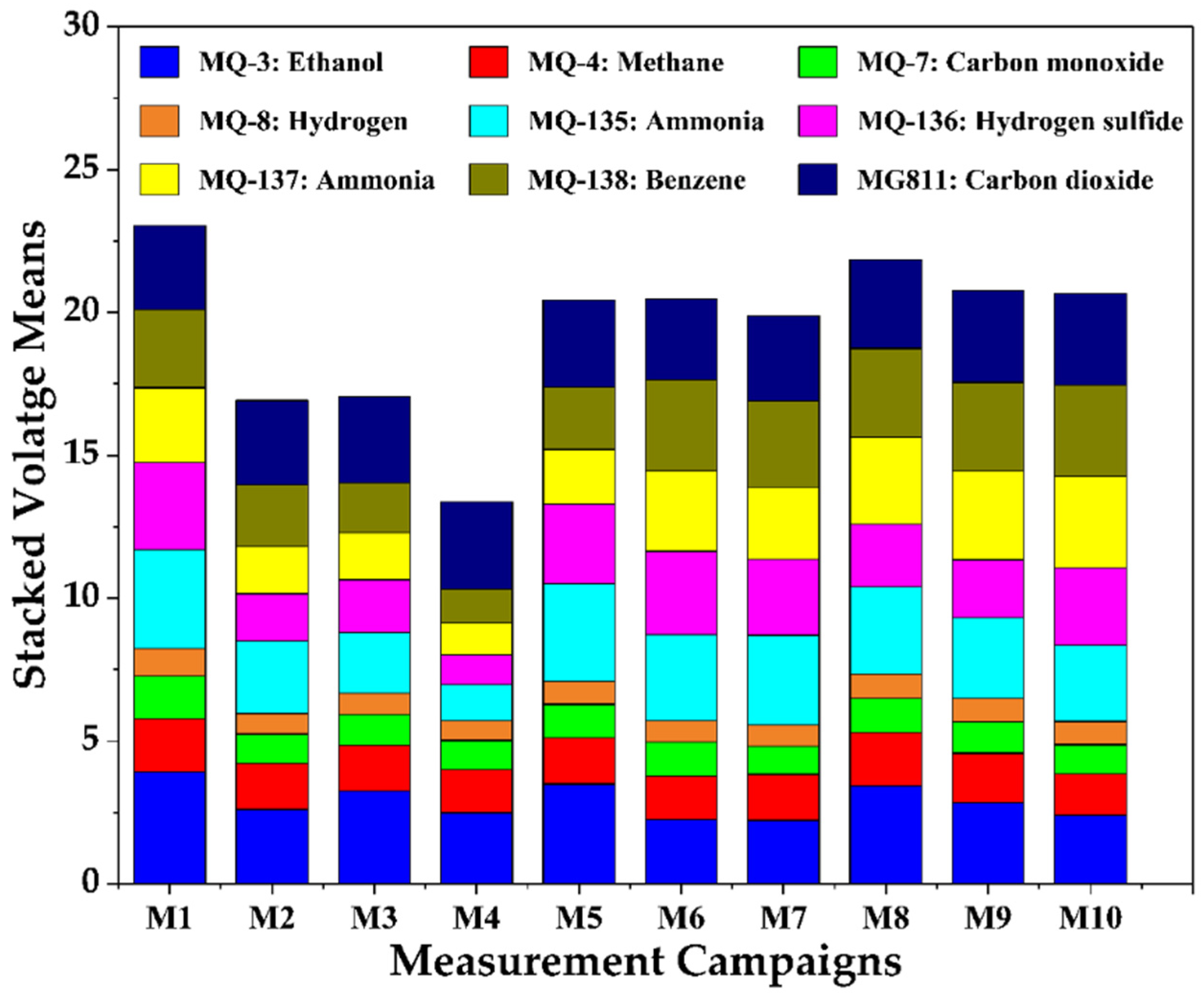
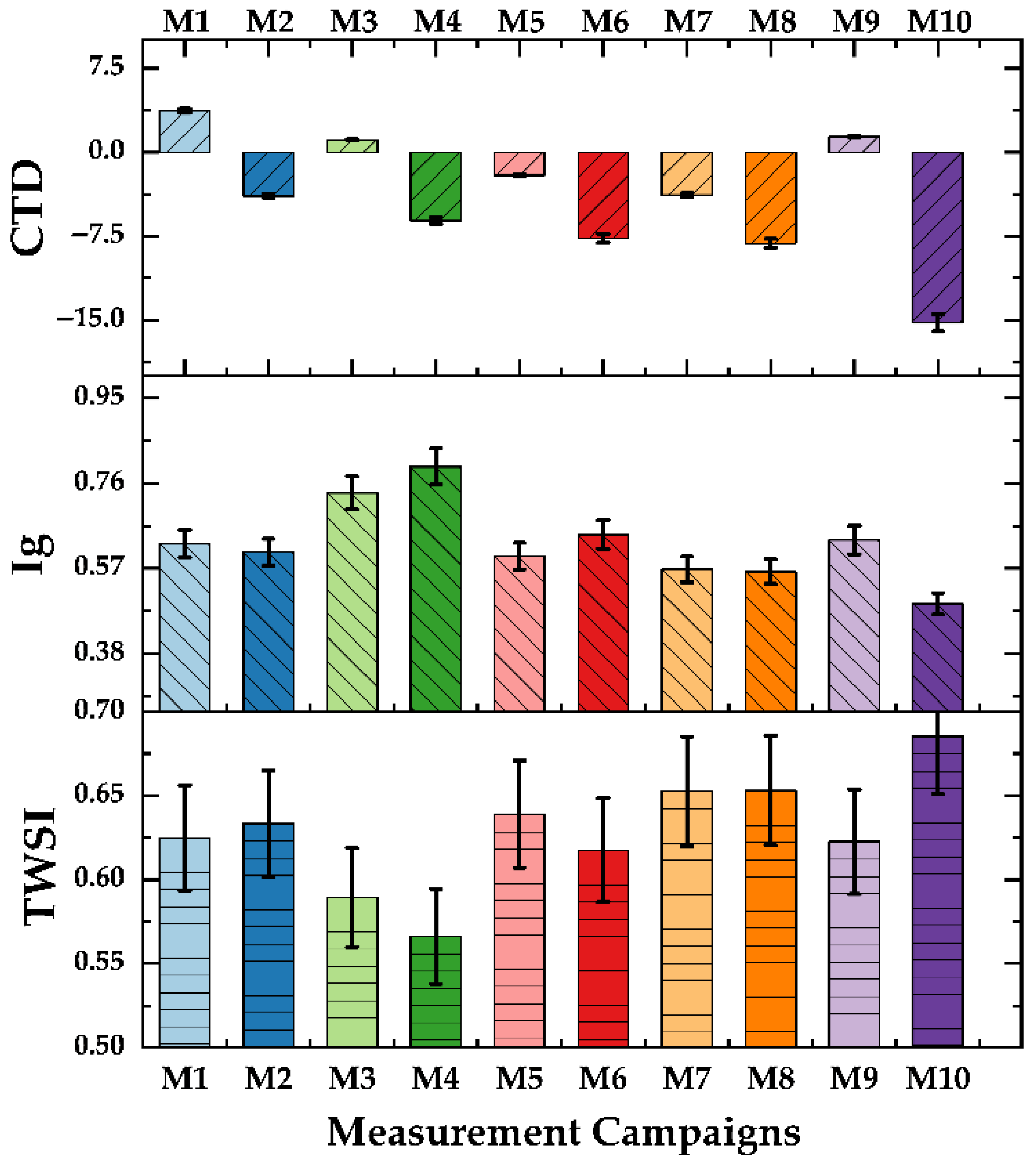

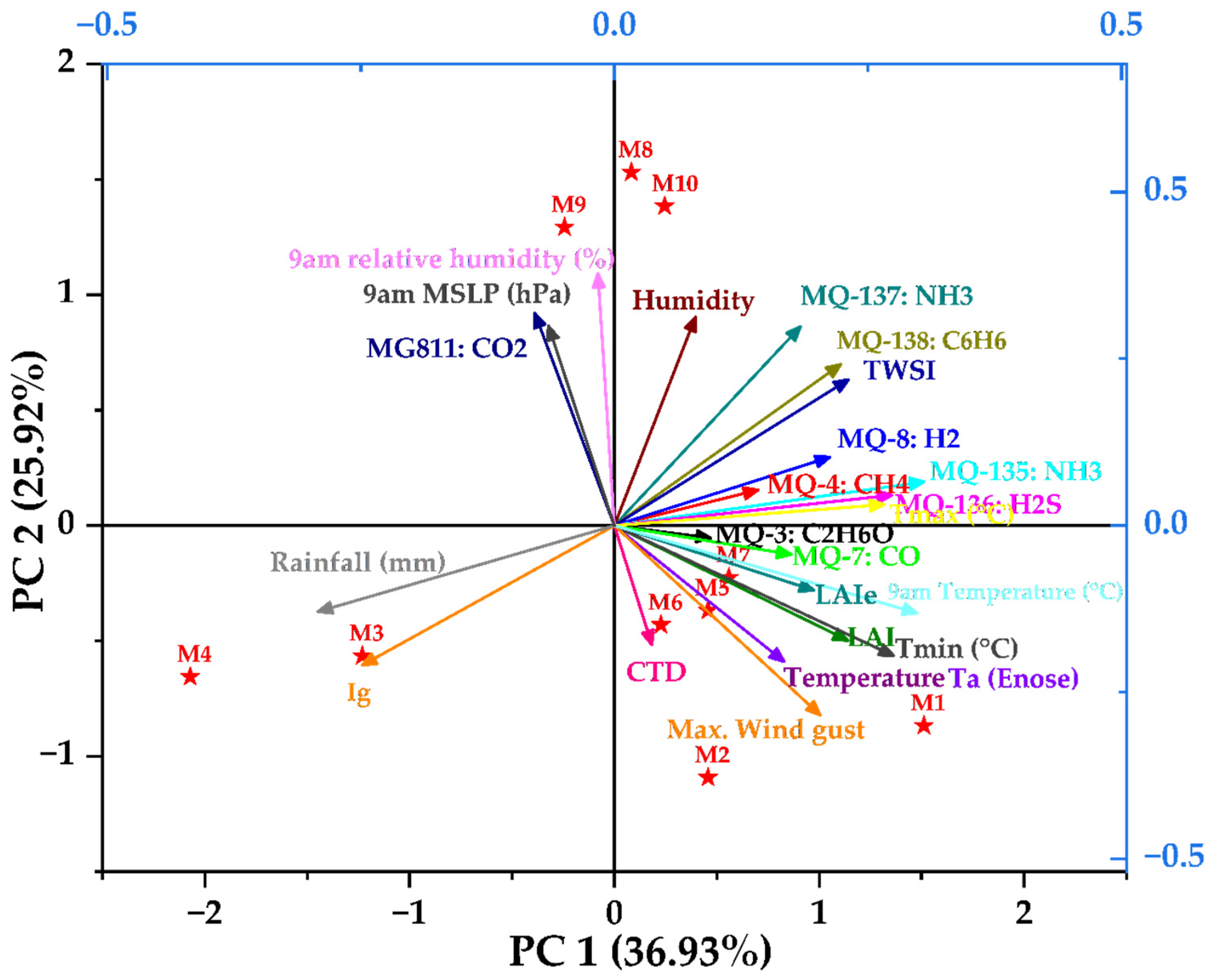
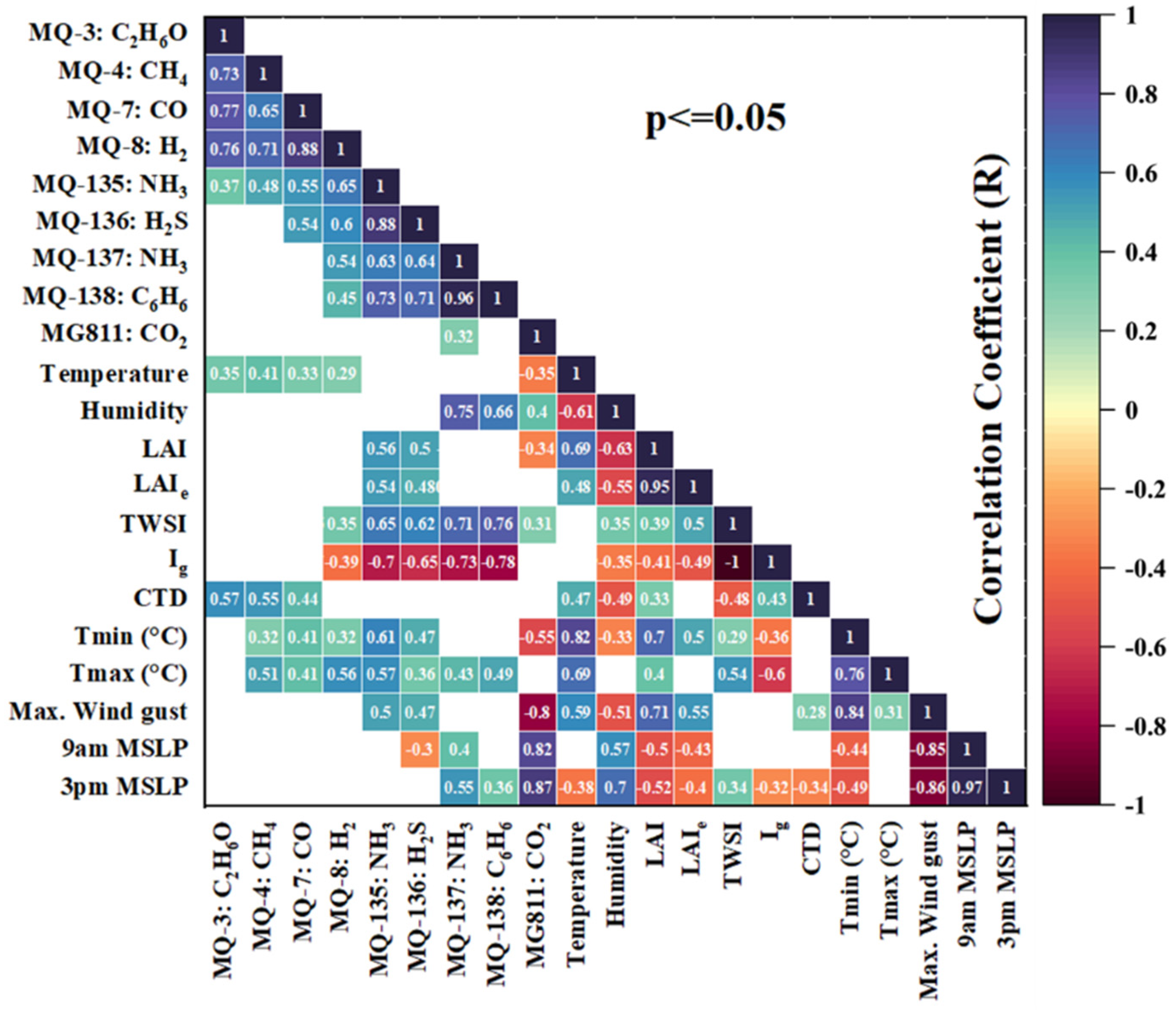
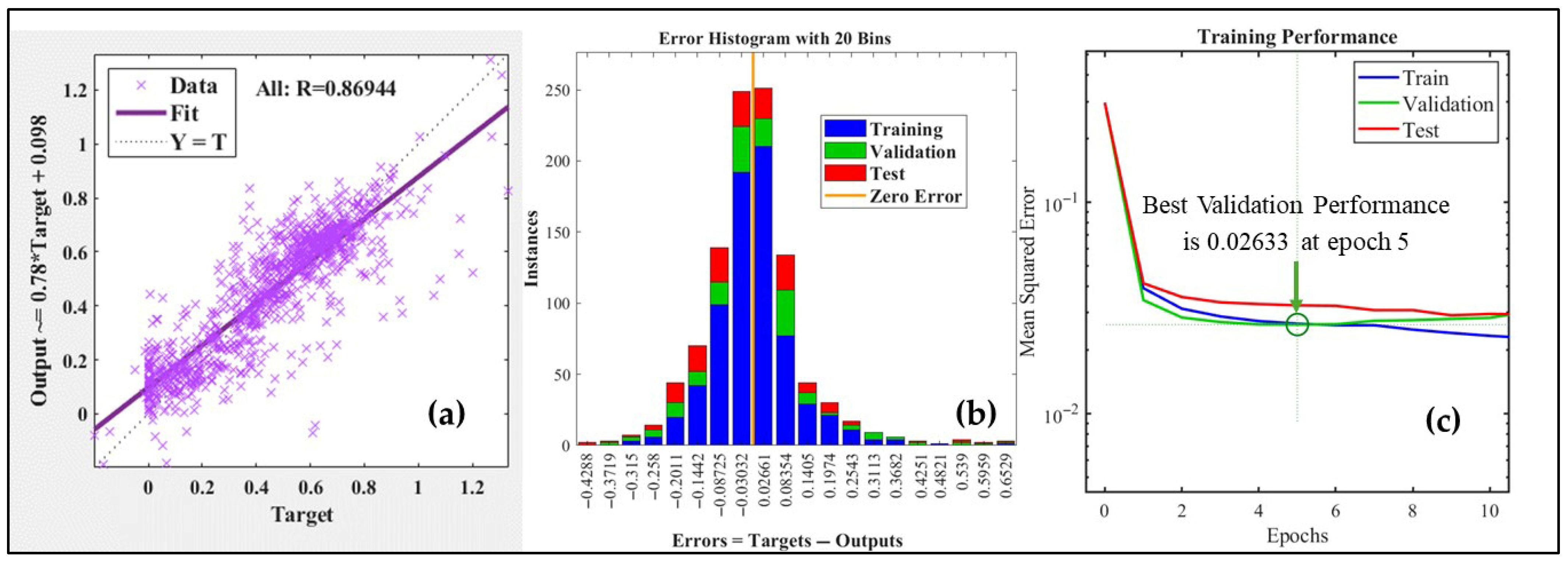
| Sensor Module | Prime Specificity | Method Detection Limits | Other Detectable Analytes 1 |
|---|---|---|---|
| MQ-3 | Ethanol (C2H6O) | 0.05 mg L−1–10 mg L−1 | CO, LPG, C6H6, Hexanes, CH4, Alcohols |
| MQ-4 | Methane (CH4) | 200–10,000 ppm | CH4, LPG, H2, CO, Alcohol, smoke |
| MQ-7 | Carbon monoxide (CO) | 20–2000 ppm | CO, H2, LPG, CH4, Alcohol |
| MQ-8 | Hydrogen (H2) | 100–10,000 ppm | H2, LGP, CH4, CO, Alcohol |
| MQ135 | Ammonia, alcohol, benzene | 10–300 ppm, 10–300 ppm, 10–1000 ppm | Acentone, Toluene, NH3, Alcohol, CO, CO2 |
| MQ136 | Hydrogen sulphide (H2S) | 1–100 ppm | H2S, NH3, CO |
| MQ137 | Ammonia (NH3) | 5–200 ppm | NH3, C2H6O, CO |
| MQ138 | Benzene, alcohol, ammonia | 10–1000 ppm, 10–1000 ppm, 10–3000 ppm | Benzene, n-Hexane, CH4, CO, Alcohol, Propane |
| MG811 | Carbon dioxide (CO2) | 350–10,000 ppm | CO2, C2H6O, CO, CH4 |
| Weather Data (Bureau of Meteorology) | ||||||||||||||||
|---|---|---|---|---|---|---|---|---|---|---|---|---|---|---|---|---|
| Date | Tmin (°C) 1 | Tmax (°C) | R (mm) | W.D | W.S (km h−1) | W.TMAX | T9A.M. (°C) | R.H.9A.M. (%) | W.D9A.M. | W.S9A.M. (km h−1) | MSL9A.M. (hPa) | T3P.M. (°C) | R.H.3P.M. (%) | W.D3P.M. | W.S3P.M. (km h−1) | MSL3P.M. (hPa) |
| 19 April | 12 | 20.6 | 0 | NW | 30 | 13:27 | 15.3 | 64 | N | 9 | 1018.4 | 18.9 | 47 | NNW | 15 | 1014.1 |
| 21 April | 7.1 | 14.9 | 10.4 | N | 19 | 23:00 | 10 | 65 | NW | 2 | 1019.2 | 14.2 | 48 | S | 7 | 1015.4 |
| 22 April | 9.9 | 17 | 0 | WSW | 30 | 16:15 | 13.4 | 62 | NNW | 13 | 1013.3 | 16.8 | 46 | WNW | 9 | 1012 |
| 29 April | 8.2 | 18.4 | 0 | SSW | 17 | 13:44 | 12 | 83 | Calm | 1025.1 | 17.5 | 66 | SSW | 9 | 1022.9 | |
| 19 April 2021 (03:02:07 p.m.) | 22 April 2021 (04:34:32 p.m.) | |||||||
|---|---|---|---|---|---|---|---|---|
| Min | Max | Mean | SD | Min | Max | Mean | SD | |
| LAI | 1.3 × 10−5 | 4.147 | 0.925 | 0.968 | 0.0005 | 3.191 | 0.988 | 0.799 |
| LAIe | 1 × 10−5 | 3.690 | 0.763 | 0.802 | 0.0005 | 3.105 | 0.966 | 0.781 |
| Tc | 11.784 | 25.568 | 22.888 | 1.765 | 3.473 | 18.326 | 10.566 | 3.565 |
| CTD | −7.316 | 6.668 | 3.682 | 1.783 | −11.127 | 4.326 | −3.827 | 3.652 |
| Ig | 0.208 | 1.235 | 0.626 | 0.213 | 0.229 | 1.292 | 0.568 | 0.252 |
| CWSI | 0.447 | 0.828 | 0.625 | 0.077 | 0.436 | 0.813 | 0.653 | 0.095 |
| Stage | Observations | MSE | R |
|---|---|---|---|
| Training | 353 | 0.0249 | 0.8240 |
| Validation | 76 | 0.0242 | 0.8126 |
| Test | 76 | 0.0228 | 0.8335 |
| Additional Test | 258 | 0.0273 | 0.86944 |
Disclaimer/Publisher’s Note: The statements, opinions and data contained in all publications are solely those of the individual author(s) and contributor(s) and not of MDPI and/or the editor(s). MDPI and/or the editor(s) disclaim responsibility for any injury to people or property resulting from any ideas, methods, instructions or products referred to in the content. |
© 2025 by the authors. Licensee MDPI, Basel, Switzerland. This article is an open access article distributed under the terms and conditions of the Creative Commons Attribution (CC BY) license (https://creativecommons.org/licenses/by/4.0/).
Share and Cite
Shahid, A.; Fuentes, S.; Gonzalez Viejo, C.; Widdicombe, B.; Unnithan, R.R. Automated Assessment of Green Infrastructure Using E-nose, Integrated Visible-Thermal Cameras and Computer Vision Algorithms. Sensors 2025, 25, 6812. https://doi.org/10.3390/s25226812
Shahid A, Fuentes S, Gonzalez Viejo C, Widdicombe B, Unnithan RR. Automated Assessment of Green Infrastructure Using E-nose, Integrated Visible-Thermal Cameras and Computer Vision Algorithms. Sensors. 2025; 25(22):6812. https://doi.org/10.3390/s25226812
Chicago/Turabian StyleShahid, Areej, Sigfredo Fuentes, Claudia Gonzalez Viejo, Bryce Widdicombe, and Ranjith R. Unnithan. 2025. "Automated Assessment of Green Infrastructure Using E-nose, Integrated Visible-Thermal Cameras and Computer Vision Algorithms" Sensors 25, no. 22: 6812. https://doi.org/10.3390/s25226812
APA StyleShahid, A., Fuentes, S., Gonzalez Viejo, C., Widdicombe, B., & Unnithan, R. R. (2025). Automated Assessment of Green Infrastructure Using E-nose, Integrated Visible-Thermal Cameras and Computer Vision Algorithms. Sensors, 25(22), 6812. https://doi.org/10.3390/s25226812








